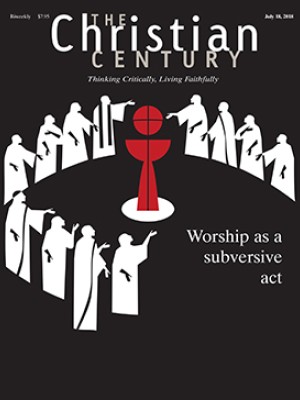A playwright's quest for a missing Pierre Teilhard de Chardin file
The Jesuit archives in Rome didn't know if they had the document. But they said I could come look for it.
Several years ago I planned to write a play about the Jesuit priest Pierre Teilhard de Chardin, a world-class geologist and paleontologist who spent his life reconciling science and religion, Christianity and evolution, matter and spirit. I believe that he saw where the human race has come from and where it is going more clearly than anyone since St. Paul. People needed to know that.
The play was to be set in 1924–25, when Teilhard was working at the National Museum of Natural History in Paris, and would dramatize two events which occurred at that time. One, he fell for a researcher named Ida Treat, a married American communist beauty, and she fell for him. The pair had tremendous arguments. “The energies were considerable,” Teilhard wrote later, with a touch of understatement. “We clashed violently” was his other, more realistic verdict. We know from Teilhard’s letters that they were strongly attracted to each other, although there is no evidence that they became sexually involved.
Read our latest issue or browse back issues.
Two, while he was trying to cope with his feelings for Ida, a copy of his recent bold essay on evolution and original sin found its way to Rome. It deeply worried the authorities there, who insisted that Teilhard sign a document called the Six Propositions. Eventually, Teilhard assented to the propositions. It was his Galileo-like surrender.
Sundry Teilhard biographers and scholars have referred to the Six Propositions, but none had ever seen them. Teilhard wrote to a friend that it was proposition four that presented the biggest problem for a Catholic priest who was also a scientist.
It was obvious that I needed to see these propositions—not least because I planned in my play to have Ida passionately urge Teilhard to refuse to sign them. I could perhaps invent the Six Propositions for my play, but it would obviously be better and safer if I could quote from the actual document.
After pestering the Congregation for the Doctrine of the Faith and the Vatican libraries, I concluded that the only copy of the Six Propositions was likely to be in the Jesuit archives in Rome and not yet available for study. Stalemate.
But in the summer of 2006, Pope Benedict XVI released all Vatican documents from 1922 to 1939 for study by scholars. I immediately wrote to the Jesuit archives, requesting a photocopy of the Six Propositions. They replied that they didn’t know if they had the document, but I was welcome to come and search for it myself. All I had to do was produce a letter of presentation from my university.
I am not an academic by trade but an actor, and I didn’t think a letter of presentation from the manager for Mary Poppins at the Prince Edward Theater was the sort of thing they had in mind. I approached friends who were professors of geology and paleontology, who wrote an eminently suitable letter of presentation. The letter worked.
At the archive, as I wrote down my subject of research, the priest at the reception area saw “Teilhard de Chardin” and giggled, “Oooooh, ’ee was naughty!!” I said that actually he wasn’t that naughty—compared, say, with assorted Borgias.
The Teilhard material is arranged in separate sections, beginning with the original typescripts of his books plus his drawings and diagrams. Lovely to see, but no Six Propositions there. I looked at a handwritten volume with copies of the letters from Rome to Lugdunum, otherwise known as Lyon, where Teilhard’s provincial superior resided. These letters covered many matters, including the grave worries aroused by Teilhard’s essay on evolution and original sin. I hand-copied letters that seemed relevant—you aren’t allowed to photocopy manuscripts in the Jesuit archives—including a letter in which the Rome boss thanked the Lugdunum boss for getting Teilhard to toe the line and sign the propositions. A third folder had the replies to Rome from Lugdunum, and I copied out more letters. But there were still no Six Propositions.
In despair, I started to reread the Rome to Lugdunum letters and noticed that, in an early one, the superior general—popularly known as the “Black Pope”—mentioned “the censure that accompanies my letter.” Hmm. “Censure . . .” It was the closest that anyone had come to mentioning propositions, so I showed this phrase to the librarian. It was now 2:30 p.m., the library closed at 5:00 p.m., and I was due to fly back to London the following morning. I asked the archivist: “Do you have a Censure file on Teilhard?” and he said, “Ah yes, we have a Censura folder for 1922–26.” He handed it to me but then snatched it away, saying, “No one has seen this before.” Then he gave it back to me.
The file contained various items, including a letter from Teilhard defending his essay to the Black Pope himself, which I’d never seen nor heard about. Then came an eight-page document in Latin by the Jesuit priest and scholar Augustin Bea, examining in detail just what was heretical or doubtful about the essay, then six pages of judicium (more Latin) by another Jesuit scholar, Henry Pinard de la Boullaye. I turned the page and found myself looking at the Six Propositions, the actual original document signed by Teilhard in Paris on July 1, 1925. And I was the first person to see it since 1925.
The simple pleasures of research.
The Jesuits even broke their own rules and photocopied it for me. And the letter from Teilhard to the superior general. I was able to make use of them in my play, Inquisition.
A version of this article appears in the print edition under the title “Teilhard’s file.”







